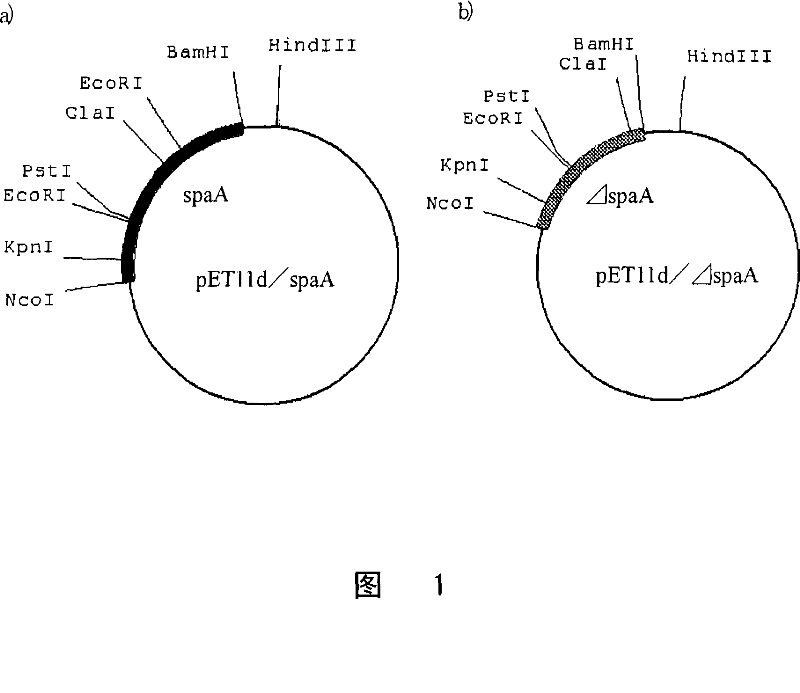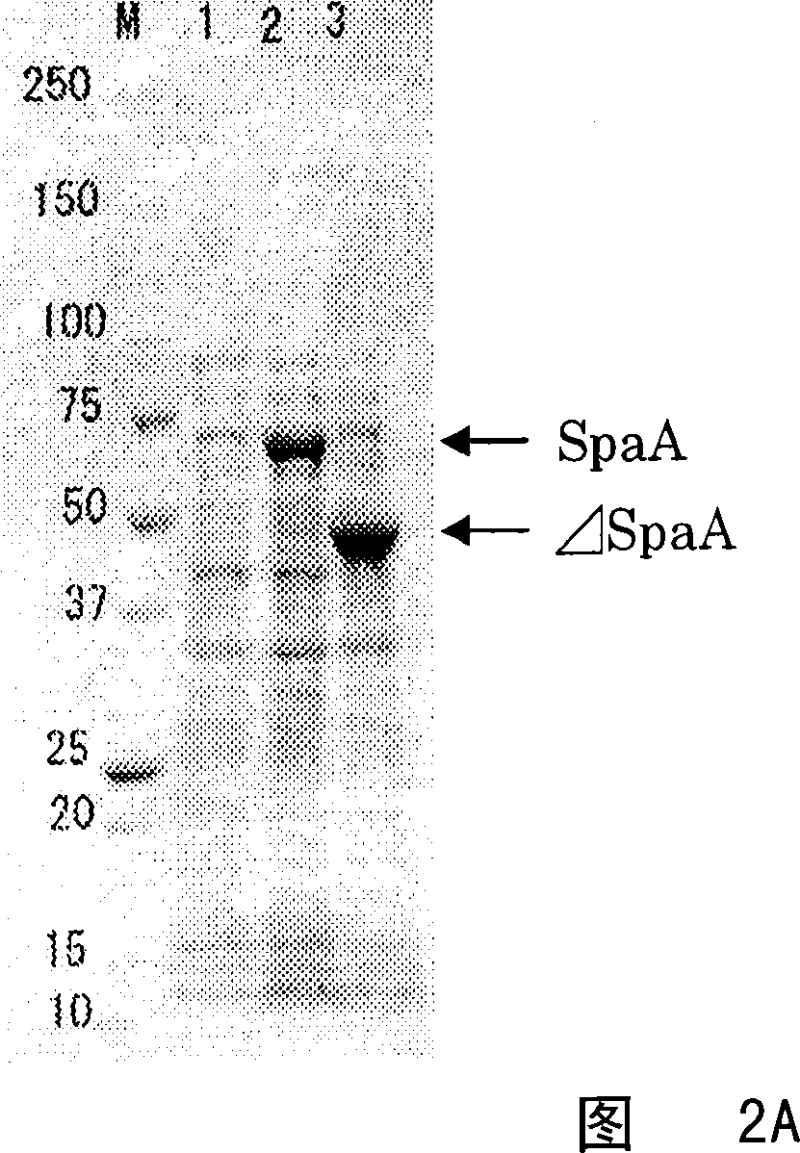Process for producing erysipelothrix rhusiopathiae surface protective antigen mutant in escherichia coli
一种猪丹毒杆菌、保护性抗原的技术,应用在抗体医疗成分、化学仪器和方法、细菌肽等方向,能够解决不容易回收和纯化、很难畜牧业者接受等问题
- Summary
- Abstract
- Description
- Claims
- Application Information
AI Technical Summary
Problems solved by technology
Method used
Image
Examples
Embodiment 1
[0096] (1) Cloning of the gene encoding SpaA protein or ΔSpaA protein
[0097] At 37°C, type 1 strains Fujisawa strain and Koganei strain and type 2 strain Tama 96 strain and SE-9 strain 16 -48 hours. Centrifuge the cultured bacteria solution (about 1.5-3.0 mL), and extract the whole genome DNA from the obtained precipitate (about 0.03 g or more) with a DNA extraction kit (Isoplant, Nippon Genes Co., Ltd.).
[0098] With this whole genome DNA as template, use the synthetic primer (SEQ ID NO:3 and 4 sequence pair, SEQ ID NO:3 and 5 sequence pair) prepared based on nucleotide sequence SEQ ID NO:1 and LAPCR kit (Baobao wine) for PCR. The reaction solution was kept at 94°C for 3 minutes, and then circulated at 94°C-60 seconds, 56°C-30 seconds and 72°C-60 seconds, repeating 30 cycles. Primer SEQ ID NO: 3 was designed to amplify the downstream region from the 79th nucleotide of the SpaA gene, and an NcoI site was added to its 5' end. Primers SEQ ID NO: 4 and 5 were designed to a...
Embodiment 2
[0109] (1) Expression of protein in the form of inclusion body caused by amino acid substitution of ΔSpaA protein
[0110] The plasmid construction method is as follows: use appropriate restriction enzymes to cut the plasmid from the clone that forms the inclusion body in Example 1-(4), and insert the obtained DNA fragment containing the nucleotide substitutions described in Table 2 into the DNA fragment encoding the expression of soluble ΔSpaA from The corresponding region in the gene of the ΔSpaA protein in the plasmid extracted from the clone of the protein (SE-9 strain).
[0111] specifically,
[0112] (a) After the plasmid from clone No.1 was double-digested with restriction enzymes EcoI and ClaI, agarose electrophoresis was performed to separate the EcoI-ClaI fragment (Fig. 4A-1), which contains the 587th-position in the gene encoding ΔSpaA protein The sequence of the 1152nd nucleotide. The resulting fragment was inserted into a plasmid from a clone expressing soluble ...
Embodiment 3
[0127] (1) Purification of SpaA protein and ΔSpaA protein forming inclusion bodies
[0128] Each of the Escherichia coli cells expressing the ΔSpaA protein in the form of inclusion bodies obtained in Example 2-(1) and the Escherichia coli cells expressing the SpaA protein in the form of inclusion bodies obtained in Example 2-(2) were cultured. Take 100ml of the culture solution, centrifuge at 10,000rpm for 5 minutes, and add 1 / 5-1 / 10 volume washing buffer (20mM Tris-Hcl pH7.5, 10mM EDTA, 1% Triton X-100), suspend the cells until uniform. Add 1 / 100 volume of lysozyme solution (10 mg / ml) to the suspension, and react at 30° C. for 15 minutes. Under ice-cold conditions, sonicate the mixture with a sonication cell homogenizer (manufacturer: Barnson Sonic Power; model: 350; output: 4; duty cycle: 30%; time: 5-15 minutes) and centrifuge at 15,000rpm 15 minutes. After recovering the supernatant, add the same volume of wash buffer (or sterile distilled water) to the pellet as the so...
PUM
 Login to View More
Login to View More Abstract
Description
Claims
Application Information
 Login to View More
Login to View More - R&D Engineer
- R&D Manager
- IP Professional
- Industry Leading Data Capabilities
- Powerful AI technology
- Patent DNA Extraction
Browse by: Latest US Patents, China's latest patents, Technical Efficacy Thesaurus, Application Domain, Technology Topic, Popular Technical Reports.
© 2024 PatSnap. All rights reserved.Legal|Privacy policy|Modern Slavery Act Transparency Statement|Sitemap|About US| Contact US: help@patsnap.com










